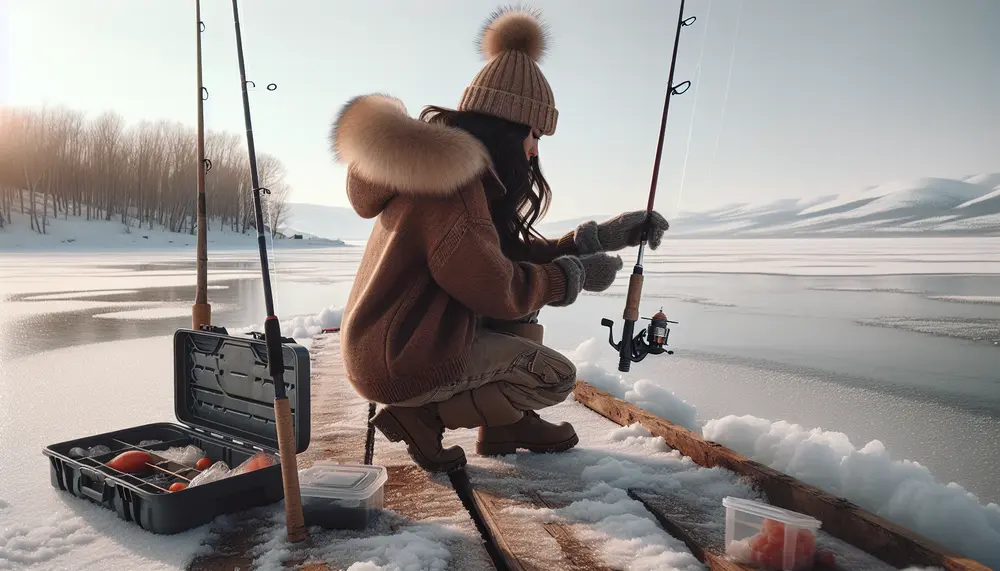Understanding the Basics of Ice Fishing Knots
Before diving into specific ice fishing knots, it's crucial to grasp the basics. Ice fishing conditions can be harsh, and the cold environment affects both your line and the knot you tie. The key to success starts with understanding that ice fishing knots must be both strong and compact to withstand the pressure of catching fish through the ice. Precision and care in tying knots ensure that they do not weaken or slip when faced with a struggling fish.
Choosing the Right Line and Gear for Ice Fishing
Selecting the appropriate line and gear is a foundational step in equipping yourself for the ice fishing season. The line you choose should be designed to perform in sub-zero temperatures, offering flexibility without brittleness. Braided lines are popular among ice anglers for their durability and sensitivity, allowing you to feel even the slightest nibble. Monofilament lines, on the other hand, offer better stretch, which can be advantageous when fighting fish. When it comes to gear, opt for an ice fishing rod that is shorter and more sensitive, complemented by a reel that can handle your chosen line with ease.
In addition to the line and rod, other gear such as ice fishing lures and jigs should be meticulously chosen to match the target species and water conditions. Smaller lures are often more effective under the ice as fish tend to be less active in cold water. Be sure to have a variety of colors and sizes to adapt to varying conditions throughout the day.
Analyzing Knot Tying Skills for Ice Fishing Enthusiasts
| Pros | Cons |
|---|---|
| Ensures strong, reliable connections | Requires time and patience to learn |
| Increases success rate of catching fish | Poor technique can lead to losing fish and gear |
| Allows for customization based on conditions | Complex knots can be difficult to tie in cold conditions |
| Enhances overall ice fishing experience | Finger dexterity is limited with gloves on |
Essential Ice Fishing Knots to Learn
Building a solid foundation in your ice fishing adventure means mastering a few key knots that are essential for various rigging scenarios. The Palomar knot is praised for its strength and simplicity, making it a go-to for securing hooks and lures. Another indispensable knot is the Improved Clinch knot, valued for its reliability and ease of tying, which is particularly useful when your fingers are cold and dexterity is compromised.
When you need to join two lines together, the Double Uni knot is your best friend. Its versatility and strength ensure that your lines stay connected. For adding a dropper or a secondary hook, mastering the Surgeon's loop is beneficial. Lastly, the Albright knot is a must-know when connecting lines of different materials or diameters, ensuring a smooth transition from line to leader.
- Palomar Knot: Ideal for attaching hooks and lures efficiently.
- Improved Clinch Knot: Offers a sturdy hold for your tackles.
- Double Uni Knot: Best for joining lines, especially when they are of varying thicknesses.
- Surgeon's Loop: Creates strong loops for adding additional hooks or lures.
- Albright Knot: Perfect for tying together dissimilar lines, particularly braided to monofilament/fluorocarbon.
Ice Fishing Knots FAQ
Why are ice fishing knots important?
Ice fishing knots are crucial because they must withstand the unique challenges of ice fishing, including harsh conditions and cold temperatures. The right knot ensures a strong and compact connection, which is essential for catching and securing fish through the ice.
What qualities make a good ice fishing knot?
A good ice fishing knot should be strong, reliable, and compact, with the ability to remain secure in sub-zero temperatures. It should also be simple enough to tie with limited dexterity, as fingers are often less nimble in cold weather.
What are some recommended knots for ice fishing?
Essential knots for ice fishing include the Palomar knot for attaching hooks and lures, the Improved Clinch knot for a sturdy hold, the Double Uni knot for joining lines of different thicknesses, the Surgeon's loop for creating strong loops, and the Albright knot for connecting dissimilar lines.
How does line choice affect knot quality?
The choice of fishing line significantly affects knot quality as different lines behave differently under strain and in cold temperatures. Braided lines offer durability and sensitivity, while monofilament lines provide better stretch. The right knot must be compatible with the type of line used to ensure the best performance.
Can weather conditions influence ice fishing knots?
Yes, weather conditions, particularly temperature, can impact ice fishing knots. Cold weather can make lines stiffer and more brittle, affecting knot strength and tying ease. Anglers must adapt their knot-tying techniques to maintain effectiveness in various weather conditions.







